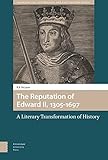The Reputation of Edward II, 1305-1697 : A Literary Transformation of History / Kit Heyam.
Material type: TextSeries: Gendering the Late Medieval and Early Modern World ; 11Publisher: Amsterdam : Amsterdam University Press, [2020]Copyright date: ©2020Description: 1 online resource (348 p.)Content type:
TextSeries: Gendering the Late Medieval and Early Modern World ; 11Publisher: Amsterdam : Amsterdam University Press, [2020]Copyright date: ©2020Description: 1 online resource (348 p.)Content type: - 9789048552146
- online - DeGruyter
| Item type | Current library | Call number | URL | Status | Notes | Barcode | |
|---|---|---|---|---|---|---|---|
 eBook
eBook
|
Biblioteca "Angelicum" Pont. Univ. S.Tommaso d'Aquino Nuvola online | online - DeGruyter (Browse shelf(Opens below)) | Online access | Not for loan (Accesso limitato) | Accesso per gli utenti autorizzati / Access for authorized users | (dgr)9789048552146 |
Frontmatter -- Table of Contents -- Acknowledgements -- Introduction -- 1. Riot, Sodomy, and Minions -- 2. From Goats to Ganymedes -- 3. Edward II and Piers Gaveston -- 4. ‘Is it not strange that he is thus bewitch’d?’ -- 5. Edward II as Political Exemplum -- 6. ‘No escape now from a life full of suffering’ -- 7. Beyond Sexual Mimesis -- Conclusion: The Literary Transformation of History -- Appendix: Accounts of and allusions to Edward II’s reign , composed 1305–1697 -- Index
restricted access online access with authorization star
http://purl.org/coar/access_right/c_16ec
During his lifetime and the four centuries following his death, King Edward II (1307-1327) acquired a reputation for having engaged in sexual and romantic relationships with his male favourites, and having been murdered by penetration with a red-hot spit. This book provides the first account of how this reputation developed, providing new insights into the processes and priorities that shaped narratives of sexual transgression in medieval and early modern England. In doing so, it analyses the changing vocabulary of sexual transgression in English, Latin and French; the conditions that created space for sympathetic depictions of same-sex love; and the use of medieval history in early modern political polemic. It also focuses, in particular, on the cultural impact of Christopher Marlowe's Edward II (c.1591-92). Through such close readings of poetry and drama, alongside chronicle accounts and political pamphlets, it demonstrates that Edward's medieval and early modern afterlife was significantly shaped by the influence of literary texts and techniques. A 'literary transformation' of historiographical methodology is, it argues, an apposite response to the factors that shaped medieval and early modern narratives of the past.
Mode of access: Internet via World Wide Web.
In English.
Description based on online resource; title from PDF title page (publisher's Web site, viewed 27. Jan 2023)


